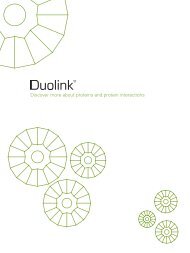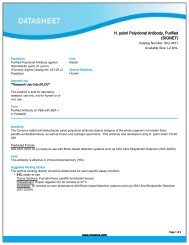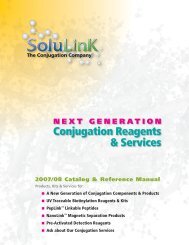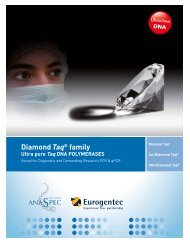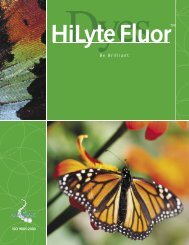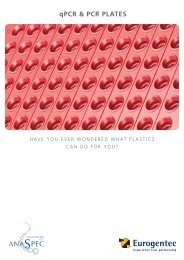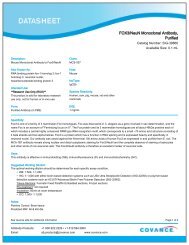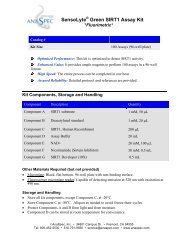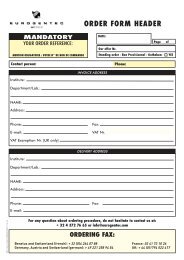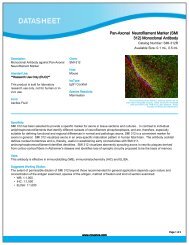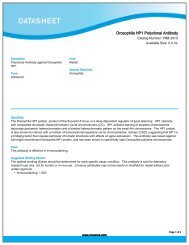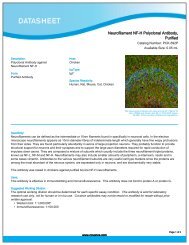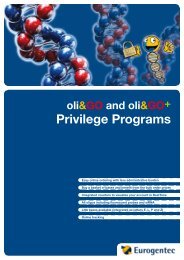qPCR MasterMix Plus Low ROX
qPCR MasterMix Plus Low ROX
qPCR MasterMix Plus Low ROX
Create successful ePaper yourself
Turn your PDF publications into a flip-book with our unique Google optimized e-Paper software.
Products and procedures described in this protocol are intended<br />
for research purposes only.<br />
Storage conditions<br />
For long term storage the <strong>qPCR</strong> <strong>MasterMix</strong> <strong>Plus</strong> <strong>Low</strong> <strong>ROX</strong> should<br />
be stored at -15 °C to -25 °C in a constant temperature freezer.<br />
When stored under these conditions the reagents are stable for<br />
2 years.<br />
For short term storage the <strong>qPCR</strong> <strong>MasterMix</strong> <strong>Plus</strong> <strong>Low</strong> <strong>ROX</strong> can<br />
be stored at 4 °C to 6 °C for 1 month.<br />
Kit contents<br />
The <strong>qPCR</strong> <strong>MasterMix</strong> <strong>Plus</strong> <strong>Low</strong> <strong>ROX</strong> contains enough reagents<br />
for up to 300 - 50 µl reactions using the hotstart enzyme,<br />
HotGoldStar.<br />
Reagent Volume Description<br />
2x reaction buffer 7.5 ml One bottle of reaction buffer,<br />
(red cap) dNTPs (including dUTP),<br />
HotGoldStar DNA polymerase,<br />
MgCl 2 (5mM final concentration),<br />
stabilizers,passive reference<br />
50 mM MgCl 1.5 ml One tube of 50 mM MgCl 2 2<br />
(plain cap)<br />
<strong>qPCR</strong> <strong>MasterMix</strong> <strong>Plus</strong> <strong>Low</strong> <strong>ROX</strong><br />
Technical Data Sheet<br />
Reference: RT-QP2X-03+WOULR<br />
Eurogentec Headquarters<br />
LIEGE SCIENCE PARK • 4102 SERAING • Belgium • Tel: +32 4 372 76 65<br />
Fax: +32 4 372 75 00 • info@eurogentec.com • www.eurogentec.com<br />
Eurogentec North America<br />
3347 Industrial Ct • Suite A • San Diego, CA 92121 • USA • Tel: +1 858 793 26 61<br />
Fax: +1 858 793 26 66 • info.usa@eurogentec.com • www.eurogentec.com<br />
Procedure<br />
1- Thaw all required reagents completely and put them on ice.<br />
Mix all reagents well by inversion and spin them down prior<br />
to pipeting.<br />
2- Prepare the reaction mix<br />
Component Volume (µl) Final concentration<br />
2x reaction buffer 25 1x<br />
Forward primer 5 (starting with 300 nM)*<br />
Reverse primer 5 (starting with 300 nM)*<br />
Probe 5 (starting with 100 nM)*<br />
Template 5 -<br />
Water 5 (volume is 50 µl minus<br />
all other components)<br />
Total Mix 50 µl<br />
*Note 1: the primer and probe concentrations are recommended as starting concentrations.<br />
These concentrations will be correct for many assays, but additional optimization of the primer<br />
concentrations and primer-probe ratios may be required to obtain the best results with your<br />
primer-probe set.<br />
Note 2: Uracil-N-Glycosylase (reference RT-0610-03) can be added to a final concentration<br />
of 0.01 u/µl (0.5 µl of 1 u/µl UNG per 50 µl reaction). If UNG is required, please add the<br />
following step in point 6 before the HotGoldStar activation step: 2 min at 50 °C.<br />
3- To correct for dispensing losses prepare an excess of reaction<br />
mix (for example 100 reactions reaction mix for 96 reactions).<br />
Add all components together, except for the template.<br />
Mix thoroughly by inversion. Spin down.<br />
4- Pipette 5 µl of the template DNA for your samples, 5 µl of the<br />
control DNA for your positive control and 5 µl of water or<br />
buffer for your negative control in to your PCR tubes / 96well<br />
plate / 384-well plate.<br />
5- Add 45 µl of the reaction mix to the reaction vial, close the vial<br />
and mix gently on a stirrer or spin down. Ensure that no<br />
bubbles are present in the reaction vial. Reaction set up can<br />
be done at room temperature.<br />
6- Program the Real-Time thermocycler using the following<br />
recommended parameters:<br />
HotGoldStar activation 10 min. 95 °C<br />
40 Cycles 15 sec. 95 °C<br />
1 min. 60 °C<br />
Hold 50 °C forever
Technical information<br />
Primer and probe design guidelines<br />
Probes:<br />
- avoid runs of identical nucleotides, especially of 4 or more Gs<br />
- when using Primer Express ® software, the Tm should be<br />
65 °C to 67 °C<br />
- avoid 5’ end G (quenches the fluorophore)<br />
- for genotyping, position of the polymorphism should be in the<br />
center of the probe, and the probe length should be adjusted<br />
such that both probes have the same Tm<br />
Primers:<br />
- GC content should be between 30 % and 80 % (ideally 40-<br />
- avoid runs of identical nucleotides, especially of 3 or more Gs<br />
- using the Primer Express ® 60 %)<br />
or Cs at the 3’ end<br />
sofware the Tm should be 58 °C to<br />
60 °C<br />
- the primer should be placed as close as possible to the probe<br />
Custom assay design<br />
Commonly used concentrations are 300 nM for primers and<br />
100 nM for probes. Optimal results may require titration of primers<br />
and probes or adjustment of the primer / probe ratio. The<br />
purpose of such a process is to determine the minimum amount<br />
of primers and probe required to obtain the most sensitive<br />
results with your assay.<br />
Primer titration matrix<br />
Titrate according to the Table 1, perform <strong>qPCR</strong> and select the<br />
concentration, which gives the lowest Ct value.<br />
By doing this type of titration it is also possible to compensate<br />
for differences up to 2 °C in melt temperature of the primers.<br />
Table 1: Primer titration matrix<br />
Forward<br />
Reverse 50 nM 300 nM 900 nM<br />
50 nM 50 / 50 300 / 50 900 / 50<br />
300 nM 50 / 300 300 / 300 900 / 300<br />
Primer-probe ratio matrix<br />
Select optimal primer concentration as described in Table 1 and<br />
test with all probe concentrations described in Table 2. Select<br />
the concentration, which gives the lowest Ct value<br />
Table 2: Primer-probe ratio matrix<br />
Probe<br />
50 nM 100 nM 250 nM<br />
Opt. primers 50 / opt 100 / opt 250 / opt<br />
MgCl 2 adjustment matrix<br />
Standard MgCl 2 concentration is 5 mM but optimal MgCl 2 concentration<br />
can vary between assay, if necessary use the<br />
50 mM MgCl 2 tube. Always prefer optimizing the primer and<br />
probe concentrations before the MgCl 2 concentration.<br />
Adjust the amount of water if MgCl 2 is added to the reaction.<br />
Final MgCl 2 MgCl 2 to add 2x reaction buffer<br />
concentration (mM) (µl/50 µl) (µl)<br />
5 0 25<br />
5.5 0.5 25<br />
6 1 25<br />
6.5 1.5 25<br />
7 2 25<br />
7.5 2.5 25<br />
8 3 25<br />
3-step protocol instead of 2-step protocol<br />
Increasing extension time or performing a 3-step protocol can<br />
increase the ÄRn and / or decrease the Ct of an assay, particularly<br />
when the PCR product is longer than 100 bp.<br />
The protocol will be as follows:<br />
HotGoldStar activation 10 min. 95 °C<br />
40 Cycles denaturation 15 sec. 95 °C<br />
annealing 20 sec. 60 °C<br />
extension 40 sec. 72 °C<br />
Increase extension time with 10-second steps, if required.<br />
Further information available through Eurogentec web<br />
site, www.eurogentec.com.<br />
- Troubleshooting Guide for <strong>qPCR</strong> and RT<strong>qPCR</strong> (under the “Technical<br />
Resources / Troubleshooting Guide” section).<br />
- Primers and probe design (please refer to our Troubleshooting<br />
Guide).<br />
- “Your One-stop-shop Real-Time <strong>qPCR</strong> supplier” handbook (under<br />
the “Technical Resources / Documentation” section).<br />
- MSDSs, (under the “Technical Resources / MSDS” section)<br />
- Certificates of Analysis (please contact us).<br />
For any further information required please contact our<br />
Customer Help Desk:<br />
For Europe:<br />
E-mail: info@eurogentec.com<br />
Tel : +32 4 372 76 65<br />
For USA:<br />
E-mail: info.usa@eurogentec.com<br />
Tel: +1 858 793 26 66<br />
FOR RESEARCH USE ONLY<br />
NOTICE TO PURCHASER: LIMITED LICENSE<br />
A license under U.S. Patents 4,683,202, 4,683,195 and 4,965,188 or their foreign counterparts, owned by Roche Molecular<br />
Systems, Inc. and F. Hoffmann-La Roche Ltd (Roche”), has an up-front fee component and a running-royalty component. The<br />
purchase price of this product includes limited, non-transferrable rights under the running-royalty component to use only this<br />
amount of the product to practice the Polymerase Chain Reaction (“PCR”) and related processes described in said patents<br />
solely for the research and development activities of the purchaser when this product is used in conjunction with a thermal<br />
cycler whose use is covered by the up-front fee component. Rights to the up-front fee component must be obtained by the end<br />
user in order to have a complete license. These rights under the up-front fee component may be purchased from Applied<br />
Biosystems or obtained by purchasing an Authorized Thermal Cycler. No right to perform or offer commercial services of any<br />
kind using PCR, including without limitation reporting the results of purchaser’s activities for a fee or other commercial consideration,<br />
is hereby granted by implication or estoppel. Further information on purchasing licenses to practice the PCR Process<br />
may be obtained by contacting the Director of Licensing at Applied Biosystems, 850 Lincoln Centre Drive, Foster City, California<br />
94404 or the Licensing Department at Roche Molecular Systems, Inc., 1145 Atlantic Avenue, Alameda, California 94501.<br />
The use of certain fluorogenic probes in 5' nuclease assays may be covered by U.S. Patents 5,210,015 and 5,487,972,<br />
owned by Roche Molecular Systems, Inc, and by U.S. Patent 5,538,848, owned by The Perkin-Elmer Corporation. The<br />
purchase of Eurogentec’s product does not provide a license to use this patented technology. A license must be obtained<br />
by contacting the Director of Licensing Applied Biosystems, 850 Lincoln Centreby contacting the Director of Licensing<br />
Applied Biosystems, 850 Lincoln Centre Drive, Foster City, CA 94404 or the Licensing Department at Roche Molecular<br />
Systems Inc., 1145 Atlantic Avenue, Almeda, CA 94501.<br />
Use of UDG employs U.S. Patents 5,035,996, 5,945,313, 5,683,896 and their foreign counterparts licensed to Eurogentec, S.A.<br />
from Invitrogen Corporation.<br />
Primer Express® is a registered trademark of Applera Corporation.



